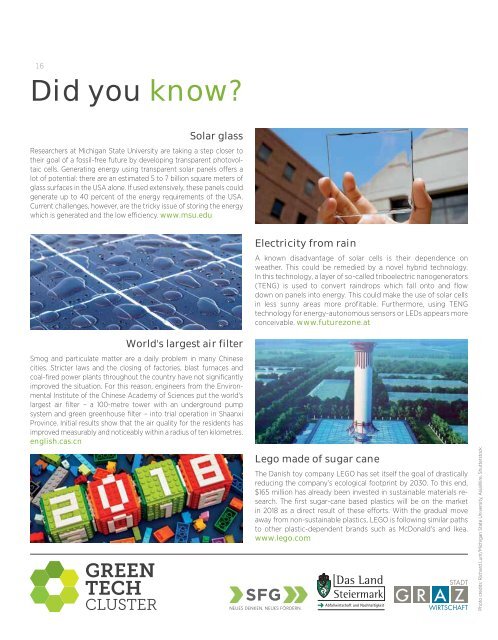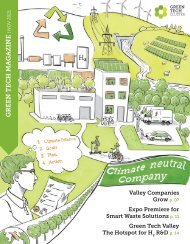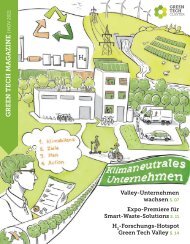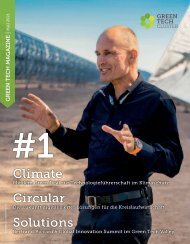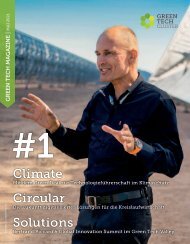Green Tech Magazine May 2018 en
Create successful ePaper yourself
Turn your PDF publications into a flip-book with our unique Google optimized e-Paper software.
16<br />
Did you know?<br />
Solar glass<br />
Researchers at Michigan State University are taking a step closer to<br />
their goal of a fossil-free future by developing transpar<strong>en</strong>t photovoltaic<br />
cells. G<strong>en</strong>erating <strong>en</strong>ergy using transpar<strong>en</strong>t solar panels offers a<br />
lot of pot<strong>en</strong>tial: there are an estimated 5 to 7 billion square meters of<br />
glass surfaces in the USA alone. If used ext<strong>en</strong>sively, these panels could<br />
g<strong>en</strong>erate up to 40 perc<strong>en</strong>t of the <strong>en</strong>ergy requirem<strong>en</strong>ts of the USA.<br />
Curr<strong>en</strong>t chall<strong>en</strong>ges, however, are the tricky issue of storing the <strong>en</strong>ergy<br />
which is g<strong>en</strong>erated and the low effici<strong>en</strong>cy. www.msu.edu<br />
World's largest air filter<br />
Smog and particulate matter are a daily problem in many Chinese<br />
cities. Stricter laws and the closing of factories, blast furnaces and<br />
coal-fired power plants throughout the country have not significantly<br />
improved the situation. For this reason, <strong>en</strong>gineers from the Environm<strong>en</strong>tal<br />
Institute of the Chinese Academy of Sci<strong>en</strong>ces put the world's<br />
largest air filter – a 100-metre tower with an underground pump<br />
system and gre<strong>en</strong> gre<strong>en</strong>house filter – into trial operation in Shaanxi<br />
Province. Initial results show that the air quality for the resid<strong>en</strong>ts has<br />
improved measurably and noticeably within a radius of t<strong>en</strong> kilometres.<br />
<strong>en</strong>glish.cas.cn<br />
Electricity from rain<br />
A known disadvantage of solar cells is their dep<strong>en</strong>d<strong>en</strong>ce on<br />
weather. This could be remedied by a novel hybrid technology.<br />
In this technology, a layer of so-called triboelectric nanog<strong>en</strong>erators<br />
(TENG) is used to convert raindrops which fall onto and flow<br />
down on panels into <strong>en</strong>ergy. This could make the use of solar cells<br />
in less sunny areas more profitable. Furthermore, using TENG<br />
technology for <strong>en</strong>ergy-autonomous s<strong>en</strong>sors or LEDs appears more<br />
conceivable. www.futurezone.at<br />
Lego made of sugar cane<br />
The Danish toy company LEGO has set itself the goal of drastically<br />
reducing the company’s ecological footprint by 2030. To this <strong>en</strong>d,<br />
$165 million has already be<strong>en</strong> invested in sustainable materials research.<br />
The first sugar-cane based plastics will be on the market<br />
in <strong>2018</strong> as a direct result of these efforts. With the gradual move<br />
away from non-sustainable plastics, LEGO is following similar paths<br />
to other plastic-dep<strong>en</strong>d<strong>en</strong>t brands such as McDonald's and Ikea.<br />
www.lego.com<br />
Photo credits: Richard Lunt/Michigan State University, AsiaWire, Shutterstock


